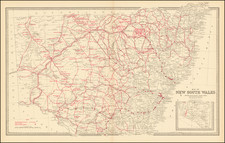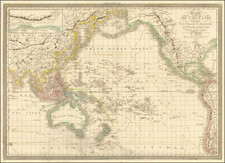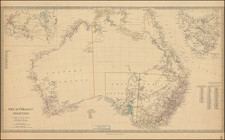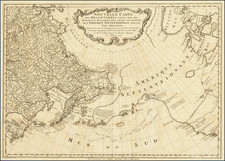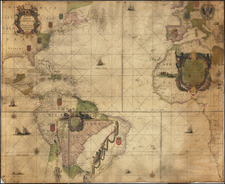A rare and fascinating map of the South Pacific Ocean, showing the tracks of Jacob Le Maire's voyage, the first to round the southern tip of South America.
This fine map illustrates the route taken by Jacob Le Maire during his epic circumnavigation of 1615-6. It shows how Le Maire, by rounding the southern tip of the Tierra del Fuego, was the first to prove that the island was not a part of an apocryphal southern continent, as previously thought, but was in fact the southern tip of South America. From there his party sailed through various Polynesian Islands, before continuing on to sail past the northern coasts of New Guinea. The map features a large inset of the northern coastline of New Guinea and a smaller inset of Le Maire's Strait and the Tierra del Fuego. The map is from De Renneville's rare Recueil des Voyages (Paris, 1725).
Jacob Le Maire (c. 1585-1616) was a Dutch mariner, the son of a wealthy merchant, Isaac Le Maire, one of the founders of the Dutch East India Company (the VOC). However, in 1605, Isaac left the VOC under acrimonious circumstances, and became determined to create his own rival company. While the VOC had a government monopoly an all trade with Asia transiting via the route around Africa, this monopoly could be legally circumvented if the Asian trade ran via another route.
In 1615, Isaac founded the Australian Company, and his first priority was to open a route to the East Indies that traversed the southern tip of the Americas. He placed Jacob in charge of the mission, and outfitted two ships, the Eendracht and the Hoorn.
In June 1615, Jacob le Maire's party left the Netherlands, and in January 1616, they sailed through a strait between Tierra del Fuego and Staten Island (Isla de los Estados), naming the passage the Le Maire Strait. From there, they rounded the extreme southernmost tip of South America, which they named Cape Horn, after the Hoorn (which had since perished in a fire).
Le Maire's party then traversed the Pacific Ocean in almost a bee-line, visiting several islands in the Tuamoto and Tonga archipelagos. By July 1616, they reached the north coasts of New Ireland and New Guinea. They finally arrived at Ternate, the VOC headquarters in the Spice Islands on September 12, 1616, where they were well received by the VOC officials, in spite of the purpose of their venture.
Unfortunately, upon arriving at Batavia (Jakarta), they encountered the terrifyingly ill-tempered VOC governor, Jan Pieterz Coen, who threw Le Maire and his men in prison and confiscated the Eendracht, claiming that Le Maire was infringing on the VOC's monopoly.
Le Maire was eventually released and was sent on his way back to the Netherlands aboard the ship Amsterdam. Sadly, Le Maire died on ship, but left an account of his voyage,
Oost ende West-Indische spieghel ('The Mirror of the East and West Inides'), which was published by his friend Joris Spilbergen (Amsterdam, 1621). Isaac Le Maire successfully sued the VOC for damages, but was not able to capitalize on the new route discovered by his son.









![[Confidential / Restricted Map -- Hawaiian Islands] Long Range Air Navigation Chart](https://storage.googleapis.com/raremaps/img/small/63172.jpg)
